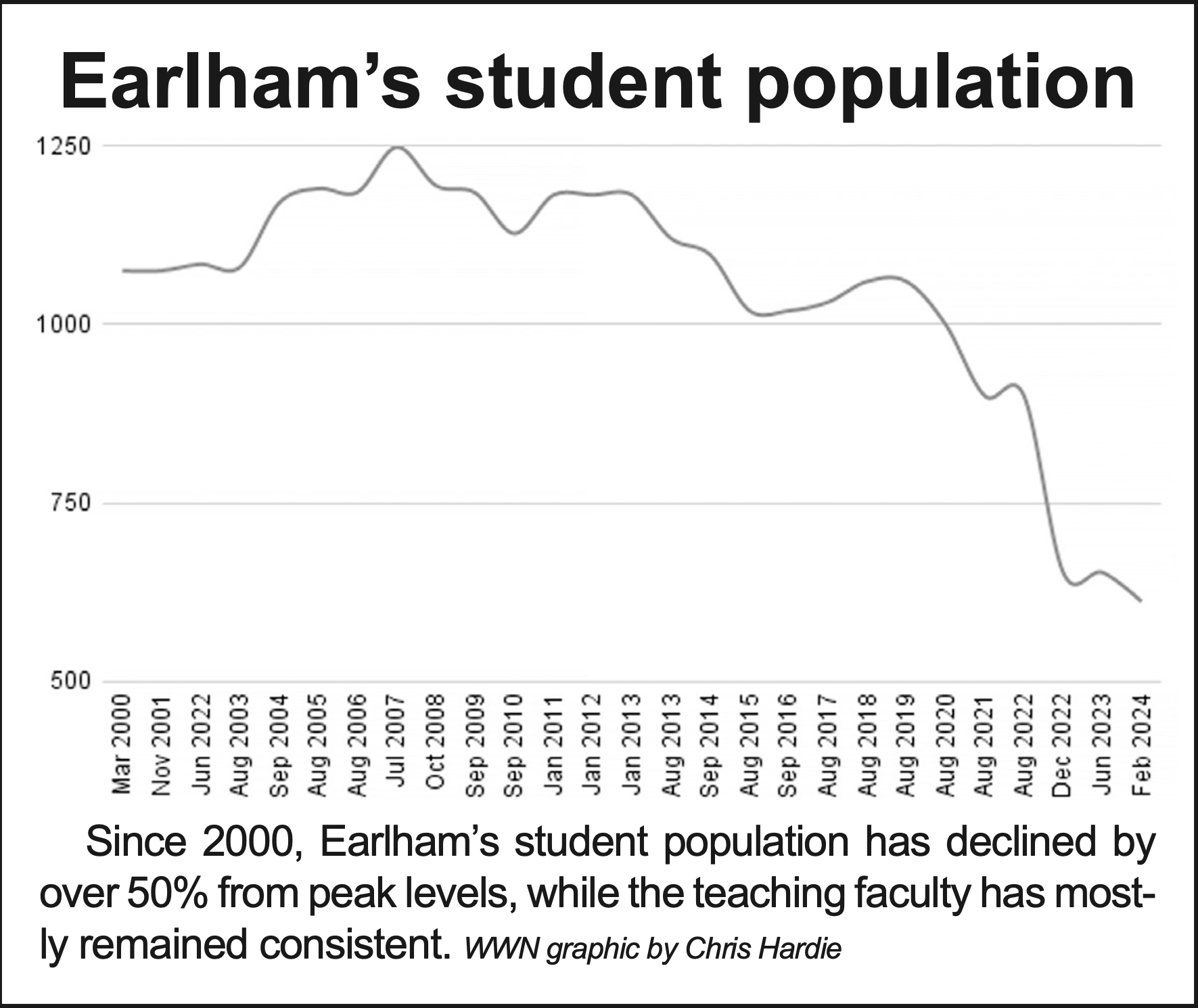Despite declining enrollment, Earlham College has largely maintained its teaching faculty size over the last 25 years. Professors and instructors have seen a drop in their compensation levels relative to average pay at similar educational institutions, and are now attempting unionization in efforts to get caught up.
In a news release, a group of the college’s teachers said that “Earlham professors are among the lowest paid among their peer institutions, and union activists seek pay on par with the industry average.”
In a statement to Western Wayne News, Earlham’s administration agreed that faculty pay “is low among our peers in the Great Lakes Colleges Association” but said that levels are “above average for private liberal arts colleges in Indiana.” The GLCA is a consortium of 13 colleges and universities across the region including DePauw University, Oberlin College, Wabash College and Earlham.
“Faculty are leaving, and it’s related to salary and child care,” said Gene Hambrick, senior executive director of the Earlham Center for Entrepreneurship, Innovation, and Creativity. Hambrick said that faculty members had been meeting for about a year to find ways to address these challenges, but recently hit a “tipping point” of dissatisfaction with the response from the college’s administrators.
On Feb. 9, faculty submitted a request to leadership to begin a collective bargaining process over pay and childcare benefits. Their news release says the request was denied, but Earlham told WWN that because such a request has the potential to impact all members of the community, it had scheduled several meetings to consult others and share the results with its board. “This decision will ultimately be made by the Board of Trustees, and we are in the process of gathering feedback from all members of the campus community to help the board make an informed decision,” a representative said.
Faculty, staff and students gathered on campus in protest on Wednesday, Feb. 21, and again asked the college to recognize its newly formed union. They said that waiting for board action is not necessary and that union recognition can happen at any senior leadership level. According to reporting by the Palladium-Item, around 100 people showed up to the protest and speakers included professors and students.
Attempts to unionize in higher education have increased around the country in recent years as budgets have tightened and the education workforce has joined other labor reform efforts. Strikes and protests can create fractures within those communities, but can also result in better pay and benefits for workers when other methods don’t succeed.
Earlham is one of the top 10 employers in Wayne County by job count, according to the Economic Development Corporation.

As a private college, Earlham operates using funds from student tuition, external donations and endowment income. According to historical student population data found on archived copies of the Earlham website, since 2000 the college’s largest enrollment was 1,248 undergraduate students in 2007, but in recent years that has dropped by almost 51%. As of this week, Earlham’s website says the current population is only 612 undergraduate students.
During that time period the college has pursued efforts to reduce costs while attempting to attract and retain students and faculty. The full-time faculty count has mostly stayed the same, ranging from around 90 to 110 throughout.
Earlham told WWN that “in 2022, all employees of the College received a 5% increase in salary. In fall 2022, Earlham launched an enrollment growth plan that will positively impact our budget moving forward. In fact, it has already led to increases in our incoming class sizes. Part of this plan includes annual pay increases of 2%, which took effect in 2023 and have been approved for 2024 and 2025.”
In GLCA data shared with WWN by unionizing faculty, the pay at Earlham during the 2021-2022 academic year for full professors was an average of $80,910, just 82% of the GLCA-wide average that year of $98,143 and 65% of the highest average level of $125,400 that year, at Denison University.
Beyond pay, the unionizing faculty said access to child care is at the core of their concerns. “Safe, affordable child care is scarce in Richmond, and professors are urging Earlham to partner with local providers to increase the supply,” their statement said. Earlham administrators agree that the issue exists and is not limited to Earlham, and said they are in the early stages of exploring possible partnerships for new options.
In results of a child care study it released in 2023 with the Purdue Center for Regional Development, the EDC confirmed that child care access was a big factor for the local workforce. Study participants had missed significant days of work due to child care challenges, and better access to child care was above vacation pay, retirement and health insurance as priorities for worker benefits. The EDC is working on tools to make finding childcare and receiving subsidies easier, as well as pursuing child care worker training and adding more seats at existing facilities.
For now, Hambrick says the goal is basic recognition of the union. “We want an opportunity for collective bargaining, to look at the books together and to work with them to improve pay levels,” he said.
For its part, Earlham’s administration said they are educating themselves on the potential impact of that approach. They told the WWN that “we are fortunate to have some of the most experienced and professional educators in the country on our faculty. We take any question from one or more of our teaching faculty very seriously.”
Disclosure: Chris Hardie is a graduate of Earlham College.
A version of this article appeared in the February 28 2024 print edition of the Western Wayne News.

